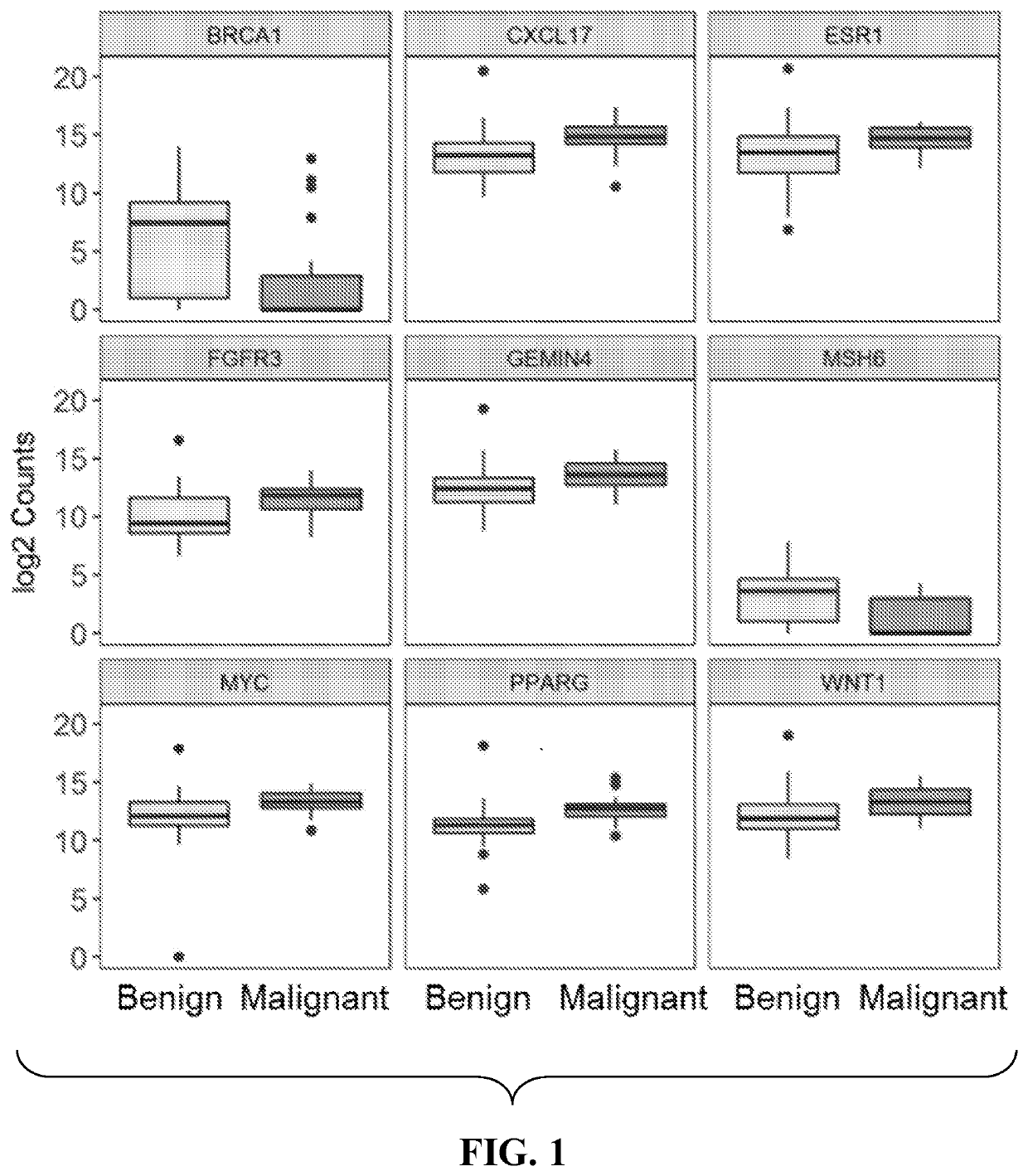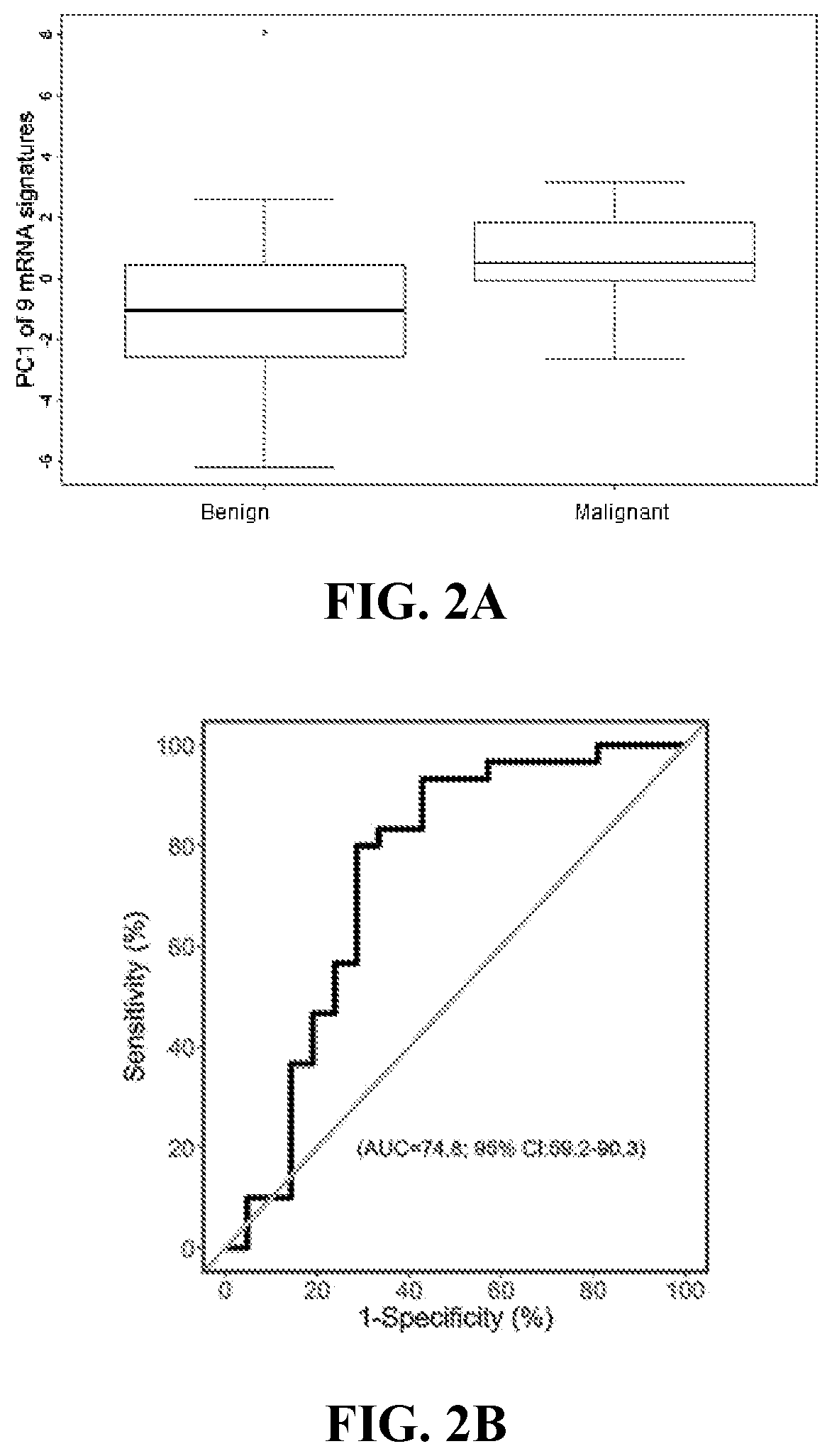Theranostic tools for management of pancreatic cancer and its precursors
- Summary
- Abstract
- Description
- Claims
- Application Information
AI Technical Summary
Benefits of technology
Problems solved by technology
Method used
Image
Examples
example 1
As as Biomarkers of Pre-Malignant Pancreatic Cysts
[0213]Pancreatic ductal adenocarcinoma (PDAC) is known for its aggressive behavior and lack of effective biomarkers to detect disease early. Circulating RNAs have been shown to be released by tumor cells into the bloodstream, to resist RNases, and be stably present at sufficient levels for molecular analyses. Studies of candidate circulating messenger RNAs (mRNAs) have previously performed using blood from PDAC cases, typically using labor-intensive RT-PCR approaches.
[0214]The inventors hypothesized that mRNAs may be shed from pancreas tissue into circulation and serve as diagnostic markers of early PDAC characterized by commonly-detected PDAC precursors known as intraductal papillary mucinous neoplasms (IPMNs). The inventors endeavored to simultaneously measure the abundance in plasma of >100 candidate mRNAs and: 1) discover mRNAs that distinguish IPMN cases from healthy controls; 2) identify mRNAs that differentiate “aggressive / mal...
example 2
c Measures of Abdominal Adiposity as Diagnostic Markers of IPMN Severity / Pathology
[0226]Intra-abdominal fat is a risk factor for pancreatic cancer (PC), but little is known about its contribution to PC precursors known as intraductal papillary mucinous neoplasms (IPMNs). Our goal was to evaluate quantitative radiologic measures of abdominal / visceral obesity as possible diagnostic markers of IPMN severity / pathology.
[0227]In a cohort of 34 surgically-resected, pathologically-confirmed IPMNs (17 benign; 17 malignant) with preoperative abdominal computed tomography (CT) images, the inventors calculated body mass index (BMI) and four radiologic measures of obesity: total abdominal fat (TAF) area, visceral fat area (VFA), subcutaneous fat area (SFA), and visceral to subcutaneous fat ratio (V / S). Measures were compared between groups using Wilcoxon two-sample exact tests and other metrics. Mean BMI for individuals with malignant IPMNs (28.9 kg / m2) was higher than mean BMI for those with be...
example 3
ng Long Non-Coding RNAs as Markers of IPMNs
[0297]Pancreatic ductal adenocarcinoma (PDAC) is an aggressive disease that lacks effective biomarkers for early detection. We hypothesized that circulating long non-coding RNAs (lncRNAs) may act as diagnostic markers of incidentally-detected cystic PDAC precursors known as intraductal papillary mucinous neoplasms (IPMNs) and predictors of their pathology. Using NanoString NCOUNTER technology, we measured the abundance of 28 candidate lncRNAs in pre-operative plasma from a cohort of pathologically-confirmed IPMN cases of various grades of severity and non-diseased controls. Results showed that two lncRNAs (GAS5 and SRA) aided in differentiating IPMNs from controls. An 8-lncRNA signature (including ADARB2-AS1, ANRIL, GLIS3-AS1, LINC00472, MEG3, PANDA, PVT1, and UCA1) performed better than standard clinical and radiologic features in distinguishing ‘aggressive / malignant’ IPMNs that warrant surgical removal from ‘indolent / benign’ IPMNs that ca...
PUM
| Property | Measurement | Unit |
|---|---|---|
| Size | aaaaa | aaaaa |
| Size | aaaaa | aaaaa |
| Fraction | aaaaa | aaaaa |
Abstract
Description
Claims
Application Information
 Login to View More
Login to View More - R&D Engineer
- R&D Manager
- IP Professional
- Industry Leading Data Capabilities
- Powerful AI technology
- Patent DNA Extraction
Browse by: Latest US Patents, China's latest patents, Technical Efficacy Thesaurus, Application Domain, Technology Topic, Popular Technical Reports.
© 2024 PatSnap. All rights reserved.Legal|Privacy policy|Modern Slavery Act Transparency Statement|Sitemap|About US| Contact US: help@patsnap.com










